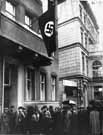
|
|
|

|

|

|

|
|
Click on an image to see a larger, more detailed picture.
|
|
|
|
|
| 1933: The Nazi State Begins |

|
pg. 65 |

|
|
|
|
| |

|
 Three young women read a sign warning German citizens against Jewish propaganda. While signs like this were common throughout Germany, the initial boycott against Jewish-owned businesses instituted in April was short-lived due to lack of support, the need to shore up the German economy, and the Nazis' fear of an international outcry. The use of bilingual placards was limited to international cities, such as Berlin, Munich, and other major shopping areas.
Three young women read a sign warning German citizens against Jewish propaganda. While signs like this were common throughout Germany, the initial boycott against Jewish-owned businesses instituted in April was short-lived due to lack of support, the need to shore up the German economy, and the Nazis' fear of an international outcry. The use of bilingual placards was limited to international cities, such as Berlin, Munich, and other major shopping areas.
Photo: UPI/Corbis-Bettmann
|
 The arrest of Jewish merchants was a familiar scene in Germany during Nazi boycott against the Jews. Observant Jews clothed in traditional garb were frequent targets of persecution and harassment. Although only a small minority of the German-Jewish community was Orthodox, the Nazis commonly displayed them as both quintessentially Jewish and "un-German."
The arrest of Jewish merchants was a familiar scene in Germany during Nazi boycott against the Jews. Observant Jews clothed in traditional garb were frequent targets of persecution and harassment. Although only a small minority of the German-Jewish community was Orthodox, the Nazis commonly displayed them as both quintessentially Jewish and "un-German."
Photo: AP/Wide World Photos
|
 Jewish lawyers wait in front of the Lawyers' Chamber building in Berlin to apply for admission. Following passage of legislation in April, the number of Jewish lawyers admitted at the Berlin courts was sharply reduced. For more than 50 years, German antisemites had campaigned to limit Jewish influence in society by restricting the numbers of Jewish lawyers, judges, and teachers.
Jewish lawyers wait in front of the Lawyers' Chamber building in Berlin to apply for admission. Following passage of legislation in April, the number of Jewish lawyers admitted at the Berlin courts was sharply reduced. For more than 50 years, German antisemites had campaigned to limit Jewish influence in society by restricting the numbers of Jewish lawyers, judges, and teachers.
Photo: AP/Wide World Photos
|
|

|

|

|

|
 May 10, 1933: Books deemed of "un-German spirit," most of them Jewish, are burned on Unter den Linden, opposite the University of Berlin, and throughout Germany. More than 20,000 volumes are destroyed, including works by John Dos Passos, Thomas Mann, Karl Marx, Ernest Hemingway, Upton Sinclair, Émile Zola, H. G. Wells, André Gide, Sigmund Freud, Maxim Gorky, Helen Keller, Friedrich Forster, Marcel Proust, Jack London, and Erich Maria Remarque.
May 10, 1933: Books deemed of "un-German spirit," most of them Jewish, are burned on Unter den Linden, opposite the University of Berlin, and throughout Germany. More than 20,000 volumes are destroyed, including works by John Dos Passos, Thomas Mann, Karl Marx, Ernest Hemingway, Upton Sinclair, Émile Zola, H. G. Wells, André Gide, Sigmund Freud, Maxim Gorky, Helen Keller, Friedrich Forster, Marcel Proust, Jack London, and Erich Maria Remarque.
|
 May 17, 1933: The Bernheim Petition, named for imprisoned Silesian Jew Franz Bernheim, is presented to the League of Nations to protest Germany's anti-Jewish legislation.
May 17, 1933: The Bernheim Petition, named for imprisoned Silesian Jew Franz Bernheim, is presented to the League of Nations to protest Germany's anti-Jewish legislation.
|
 May 17, 1933: In Norway, Vidkun Quisling establishes the Norwegian Fascist Party as well as the Hirdmen (King's Men), a collaborationist organization that's modeled on the Nazi Sturmabteilung (SA).
May 17, 1933: In Norway, Vidkun Quisling establishes the Norwegian Fascist Party as well as the Hirdmen (King's Men), a collaborationist organization that's modeled on the Nazi Sturmabteilung (SA).
|
|
|
|
|
| 1933: The Nazi State Begins |

|
pg. 65 |

|
|
The Holocaust Chronicle
© 2009 Publications International, Ltd.
|
|
